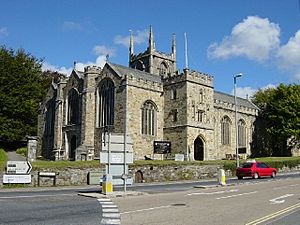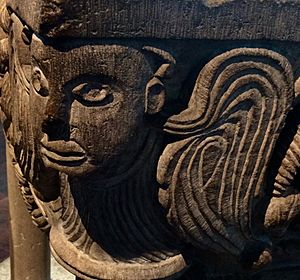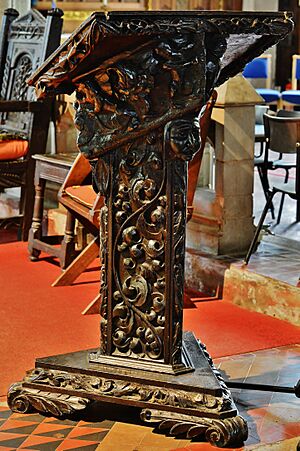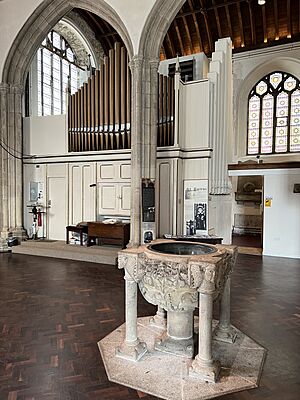St Petroc's Church, Bodmin facts for kids
Quick facts for kids St Petroc's Church, Bodmin |
|
|---|---|

St Petroc's Church, Bodmin, from the southwest
|
|
| 50°28′17″N 4°43′00″W / 50.4714°N 4.7168°W | |
| Denomination | Church of England |
| Churchmanship | High |
| History | |
| Dedication | St Petroc |
| Administration | |
| Parish | Bodmin |
| Deanery | Trigg Minor |
| Archdeaconry | Bodmin |
| Diocese | Truro |
| Province | Canterbury |
St Petroc's Church, Bodmin, also known as Bodmin Parish Church, is an Anglican church in the town of Bodmin, Cornwall, England. It's a special place where people have worshipped for hundreds of years.
The main church building you see today was built between 1469 and 1472. For a long time, it was the biggest church in Cornwall, until Truro Cathedral was built. Originally, it was a Roman Catholic church, but it became an Anglican church during the English Reformation. The church has an old tower from the original Norman church, which stands on the north side. This tower used to be about 46 meters (150 feet) tall, but its spire (the pointy top) was lost in 1699. The church has been repaired and updated several times, including in the Victorian era and again in 1930. Today, it is a Grade I listed building, which means it's a very important historical site. A part of the church is also a special chapel for the Duke of Cornwall's Light Infantry, a military regiment.
The church is part of a group of parishes, including Bodmin, Cardinham, Lanivet, and Lanhydrock. There is also a smaller chapel at Nanstallon.
Contents
History of St Petroc's Church
The early story of the monastery in Bodmin isn't very clear. However, the name "Bodmin" comes from a Cornish phrase meaning "house of the monks," which suggests a monastery was there a long time ago. People believe that Saint Petroc founded a monastery in Bodmin in the 6th century, after starting one in Padstow. This is why Bodmin was sometimes called Petrockstow.
Some stories say that another saint, St Guron, was here before St Petroc. King Athelstan is also said to have helped establish the monastery, though it probably existed before his time. Sadly, it was destroyed in a Viking raid in 981 AD. But it was rebuilt and became very important, owning a lot of land by the time of King Edward the Confessor.
The Domesday Book, a famous survey from 1086, shows that the monastery still owned 18 large estates, including Bodmin and Padstow. Later, around 1120, a group of Augustinian canons (a type of religious order) took over the monastery. In 1177, some special items belonging to St Petroc were stolen, but they were found and returned. The ivory box they were kept in is still around today!
During the time of King Henry VIII, the priory (monastery) was closed down. Before that, the canons used the choir part of the church, and the local people used the nave. A writer named John Leland noted that different religious groups, including monks, nuns, and priests, had used the church over the years.
Church Restoration in 1884
In 1868, an architect named Robert Jewell Withers was asked to check the church and estimate the cost of repairs. It took many years to raise the money, but by late 1884, the main structural work was finished. The total cost was over £3,000. The Bishop of Truro officially reopened the church for worship on Christmas Day that year.
The restoration mainly focused on the eastern part of the church. Many windows were replaced or repaired, and two new memorial windows were added. The old roof was mostly replaced with new wood, and the floors were redone with tiles and wood. The special area for the choir and altar was also updated with new tiles and choir stalls. A new cedar wood altar was installed, and the church was fitted with a new heating system. The old organ was replaced with a new one, which took a few more months to complete. Overall, the church looked much more beautiful after the restoration.
Parish Status
St Petroc's Church is part of a group of churches in the area. This means it shares a vicar and works closely with:
- St Hydroc's Church, Lanhydrock
- Lanivet Church
- St Stephen's Church, Nanstallon (a smaller chapel)
- St Meubred's Church, Cardynham
Features of St Petroc's Church
The church has many interesting things to see, including old memorials and special historical items.
Prior Vyvyan's Tomb
One of the most notable memorials is the tomb of Prior Vivian. He was the second-to-last leader of Bodmin Priory. In 1517, he became a bishop for a place called Megara in Greece. This allowed him to help the Bishop of Exeter with church duties in Cornwall. Prior Vyvyan also built a nice home for himself at Rialton, which was the priory's main estate. Even after the priory was closed, his tomb was saved and moved into the parish church, where you can still see it today.
Baptismal Font
The church has a large and beautifully carved baptismal font from the 12th century. This type of font is common in Cornwall, but Bodmin's is known for being the biggest and most decorated of its kind.
Woodwork
The church has some amazing old wooden features.
- Screen, Pulpit, and Bench-ends
In 1491, a craftsman named Matthy More was hired to put in new seating and build the rood screen and pulpit. This work took four years. Parts of his original work can still be seen today in the carved ends of the wooden benches and in panels that have been reused in other parts of the church, like the special seats for the town council, wall panels, and the pulpit.
- Misericords
Unusually, three special carved seats called misericords from the late 15th century are now part of the church's lectern (a stand for reading). These misericords were probably not originally from St Petroc's. It's thought they were moved and put into the lectern sometime in the 1700s.
Churchyard
The churchyard is very large and sits on a slope. You can find the ruins of the Chapel of St Thomas Becket, which was built in the 14th century, in the southeast part of the churchyard. Near the western entrance to the churchyard is St Guron's Well, a small building made of granite.
Bells
The church tower holds a set of eight bells. The largest bell, called the tenor bell, weighs about 17 hundredweight (which is about 860 kilograms or 1,900 pounds).
Organ
A large organ with three keyboards was installed in the church in 1775 by Brice Seede. It was first placed in a gallery at the western end of the church, but later moved to the north side. Parts of the organ were used in the main part of the church from 1876.
The organ has been repaired and updated several times by companies like Hele & Co and Percy Daniel. You can find more details about this organ on the National Pipe Organ Register.
Images for kids






